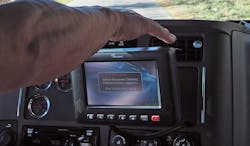FMCSA proceeds with December ELD enforcement plan
ATLANTA. Despite recent speculation regarding potential delays for the electronic logging device (ELD) mandate, the Federal Motor Carrier Safety Administration (FMCSA) is proceeding with its plan to begin enforcing the rule on Dec. 18.
“We won’t be putting drivers out of service for simply failing to have an ELD, but if they’re not compliant with the hours of service rules or don’t have a paper record that shows that they’re compliant, they’ll continue to be put out of service,” explained Jon Dierberger, field administrator at FMCSA, during TU-Automotive’s Connected Fleets event. “That rule will still remain in effect.”
The rule went into effect back in 2015 and the industry has been in a voluntary early adoption phase ever since. However, a study of 529 U.S. fleet operators released by C.J. Driscoll & Associates found there's a long ways to go yet when it comes to adopting ELDs. A solid majority — 60% — of commercial fleets included in the study were still using paper logs to monitor drivers' hours of service.
In the same study, not a single owner-operator polled had implemented an ELD or planned to by Dec. 18.
Dierberger explained that for the next two years the FMCSA will only allow the use of grandfathered in automated onboard recording devices (AOBRDs) that have been in use and installed prior to the Dec. 18 deadline. But, if one of those devices malfunctions and has to be replaced, it has to be replaced with an ELD, he stressed.
Two years after the compliance date – Dec. 16, 2019 – all devices must be ELD compliant. AOBRDs will need to be upgraded or replaced if they can’t meet the ELD standard, according to Dierberger.
ELDs must be registered with FMCSA, which does not enforce any kind of validation process for product manufacturers. Currently, at least 80 self-certified devices have been registered with the FMCSA.
“As we go out and conduct compliance investigations, that’s when we find out just how compliant they are with the specification,” Dierberger explained. “So we are advising that motor carriers be very careful about who they’re doing business with.”
So what happens when there’s a cyber breach, some hacker develops an app that looks like an ELD, but isn’t, or someone tampers with a device? Dierberger said FMCSA encourages that vendors build secure systems to accurately record hours of service, but ultimately, the burden of compliance will fall on the motor carrier.
“We don’t regulate the vendors, we regulate the motor carriers,” he said. “If this happens, notify your drivers of a noncompliant device, and they will have eight days [to fix the problem]. If they notify the vendor, but the vendor is revoked, those devices are noncompliant and they cannot be used.”
Implementation, enforcement and officer training
Though FMCSA has begun training federal and state inspectors, Dierberger noted that with 80 different devices out there, the agency isn’t focused on getting officers to try to understand how to read or react or use the interfaces on all of these different devices. The idea is that officers will look for certain data, which be transferred directly from the device to the officer for review.
“That’s one of the advantages and changes with the ELD rule – we specified a standard data set,” Dierberger said. “The AOBRD mandate did not do that. Standard data set allows us to display the hours of service information to the officer using a standard interface.”
A software application for that, called eRODS, is in the final stages of being tested by FMCSA. Under the new rule, if the data transfer fails or is unavailable, as a backup, devices must have a display or print out capability so officers can review hours of service data even when it can’t be transferred.
Backup options to transfer data are:
Telematics options, including either web services or email. The driver will enter a code that’s specific to the officer, transfer the data to FMCSA web services, the officer will connect to FMCSA’s web service system, and the logs will be routed to that officer using that specific code.
Local options when there is no connectivity include Bluetooth and USB. USB would be the most prevalent option here, Dierberger noted. “But we’ll have to see how the IT security people feel about that with the police officer having access to their systems as a lot of them have very sensitive data on their laptops.”
Dierberger added that ELD vendors must comply with at least one of the telematics options as well as one of the local transfer options. Ultimately, it will be up to individual states to choose what method to use to obtain that data from the driver.
“I think it’s going to be important these devices as many of the options as possible,” Dierberger said. “There’s a minimum, but different states are going to have different preferences, different officers, and we want to try to facilitate the inspection process. We don’t want people sitting at scale houses while somebody tries to figure out how to get the data transferred.”
ELD impact
FMCSA projects the ELD mandate will impact 3.4 million drivers. During an analysis for the cost and safety benefits, the agency estimated 1,800 crashes will be avoided and about 26 lives will be saved per year after full ELD implementation.
According to Harry Storck, global fleet technical specialist at AIG, nearly 1.3 million people are killed globally in accidents each year. He added each accident with an injury is somewhere in the neighborhood of a $300,000 claim. And with more and more people on the roadways, that risk exposure isn’t likely to decrease.
“The biggest contributor to the level of accidents and fatalities is the increased number of miles driven,” Storck explained. “Mileage driven has been increased in the last three years. It’s the exposure of the more time that you’re on the road and driving, the higher the exposure in claims.”
According to Dierberger, the major impacts of the ELD rule at least on a near real-time basis, are motor carriers will have a better understanding of how many problems they are having with hours of service compliance, availability of driver hours of service, and there could be a potential lead to efficiencies of dispatching those drivers.
In addition, ELDs are designed to automatically record a driver’s driving time, engine hours, vehicle miles, date/time, and other safety measures companies are tracking. The devices will also record data for fleet management use, such as monitoring fuel efficiency, hard stops, speeding, and unsafe lane changes.
Those with questions can email them to [email protected].
About the Author

Cristina Commendatore
Cristina Commendatore is a past FleetOwner editor-in-chief. She wrote for the publication from 2015 to 2023.


